
A Lifeline
Missinippi Airways flies thousands of kilometres each day to serve remote Indigenous communities.

Canada has some of the most isolated communities in the world. Many of these are First Nations with growing populations and transportation challenges. Missinippi Airways is an Indigenous owned airline formed to meet these challenges. Each day they fly thousands of kilometres making sure people in the north get what they need and where they want to go.

A lot of their work involves typical airline services. They operate scheduled and charter passenger flights so that people can get to meetings, take vacations, and visit friends. They deliver much needed cargo, special packages, and even hard to get food items, in and out of northern communities.
But it is their medivac services that truly makes them a lifeline for the people living up north. Most of the communities they serve don’t have hospitals, some don’t even have a resident doctor or nurse. If you have a major health issue, that means travelling south to Thompson’s Regional hospital but more often, to Winnipeg which is home to world-class medical centres.
Operating an airline in the north comes with unique challenges. Remote flights mean short gravel airstrips and runways, with no air traffic controllers, no radar coverage below a certain point, bad weather, and snow covered runways. As a pilot, you’re on your own. The weather makes scheduling flights and keeping aircraft and runways maintained difficult too. And finding qualified pilots, aeromedical crew, and aviation mechanics who want to work in these conditions is an on-going challenge.
Fortunately there is a great team in place committed to keeping things running smooth and growing the operation.
Missinippi Airways flies primarily in Manitoba, but also across northern Saskatchewan, Ontario, and even Nunavut. It operates out of its bases in The Pas and Winnipeg, and from offices and medivac hangars in Thompson, Norway House, and Pukatawagan.
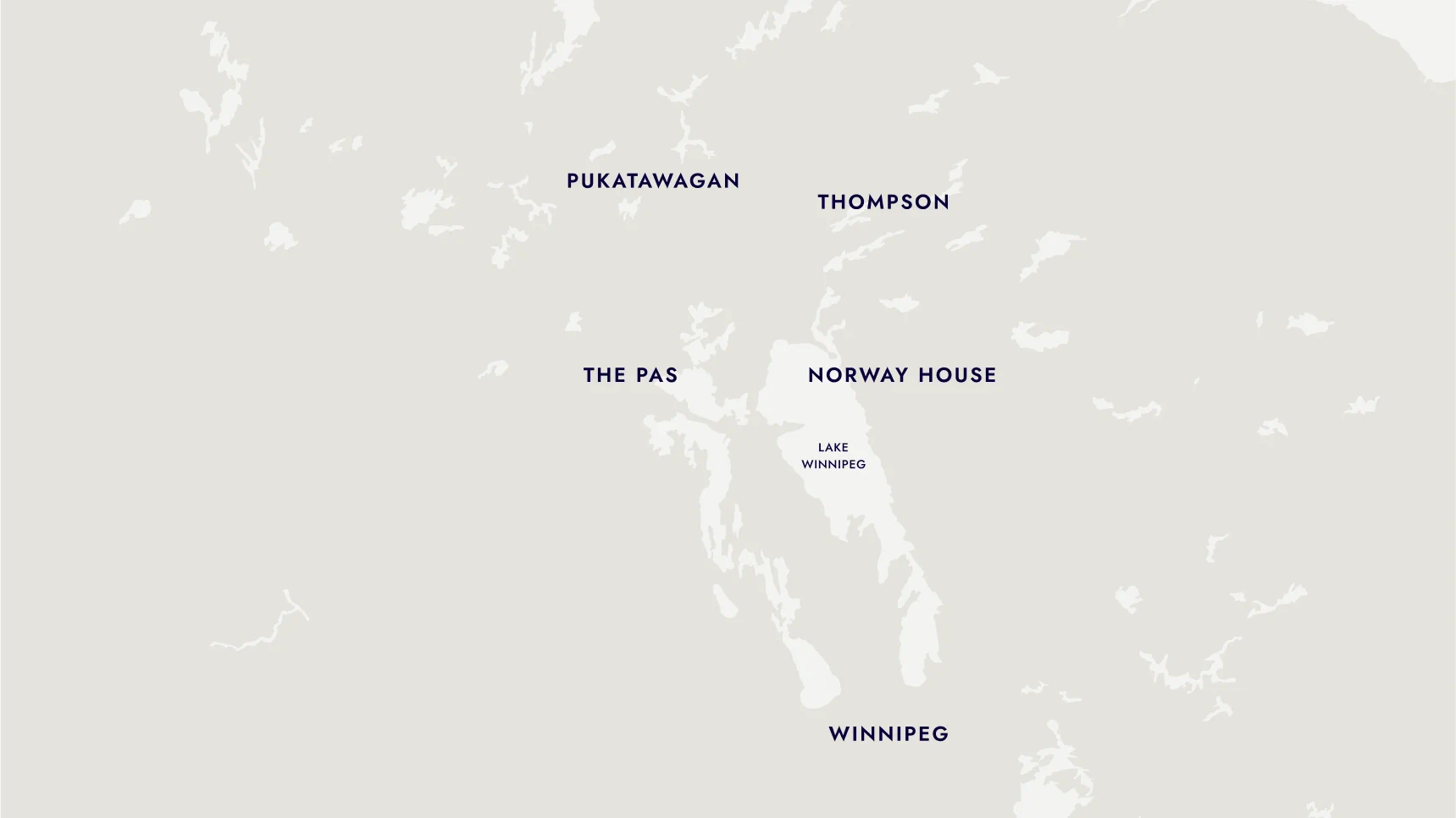
Pukatawagan is home to the Mathias Colomb Cree Nation. They started Missinippi Airways to service their community and scheduled flights go from the terminal here to The Pas and back seven days a week. This service empowers their people allowing them to travel, bring-in supplies, and access business, recreation, education, and healthcare opportunities.
The Pas is home to the Grace Lake airport, and Missinippi Airways’ primary base of operations. The airport, which Missinippi acquired in 2019, is equipped with runways and a passenger terminal. It’s also home to their flight operations team, runway maintenance crew, and hangars where inspections and maintenance are done on the airline’s Piper Navajo Aircraft.
Thompson is the largest city and most populated municipality in Northern Manitoba. A hangar at the city’s regional airport serves as a base for Missinippi Air pilots and medivac teams who bring patients into the Thompson Regional Hospital or out to Winnipeg.
This town, located just north of Lake Winnipeg, is home to the Norway House Cree Nation. There is a small airport with a crushed rock runway and a medivac hangar that Missinippi Air pilots and medivac teams use to serve patients and drop supplies.
Winnipeg is a major city and a key destination for the airline’s passengers. Most medivac patients are flown here to receive care in the city’s modern hospitals and clinics. As Missinippi Airways has grown so has its presence in Winnipeg, having established an important maintenance base and new head offices at the south terminal of the city’s international airport.
Missinippi Airways flies primarily in Manitoba, but also across northern Saskatchewan, Ontario, and even Nunavut. It operates out of its bases in The Pas and Winnipeg, and from offices and medivac hangars in Thompson, Norway House, and Pukatawagan.
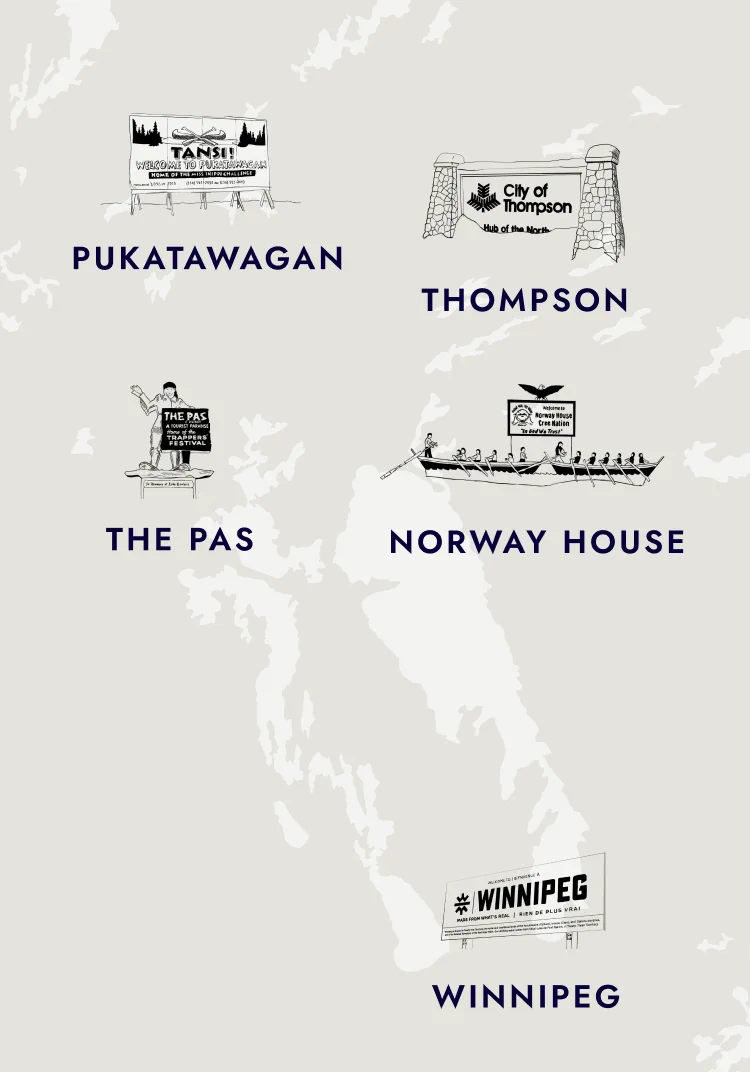
Pukatawagan is home to the Mathias Colomb Cree Nation. They started Missinippi Airways to service their community and scheduled flights go from the terminal here to The Pas and back seven days a week. This service empowers their people allowing them to travel, bring-in supplies, and access business, recreation, education, and healthcare opportunities.
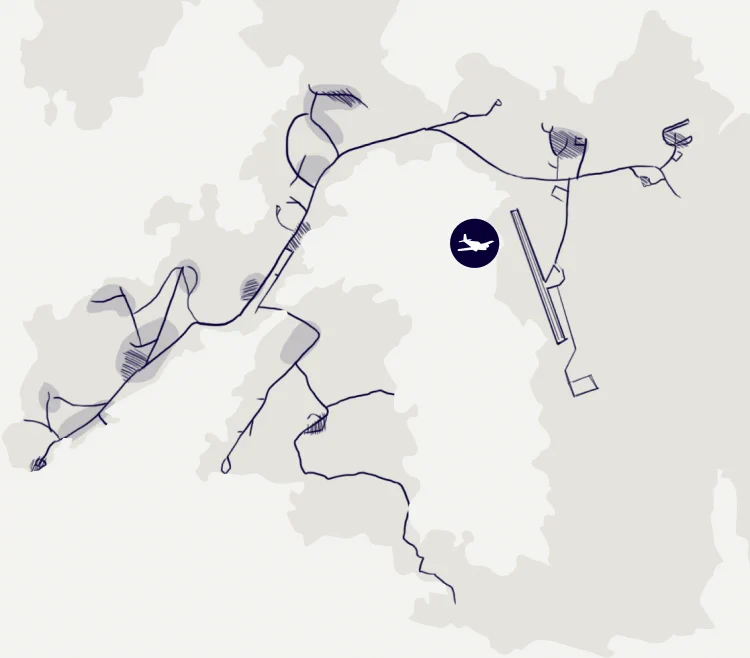
The Pas is home to the Grace Lake airport, and Missinippi Airways’ primary base of operations. The airport, which Missinippi acquired in 2019, is equipped with runways and a passenger terminal. It’s also home to their flight operations team, runway maintenance crew, and hangars where inspections and maintenance are done on the airline’s Piper Navajo Aircraft.
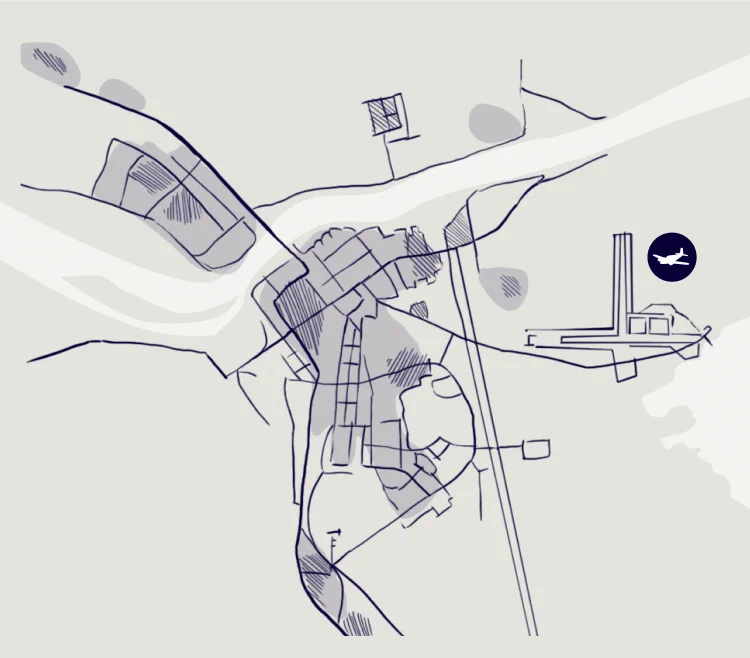
Thompson is the largest city and most populated municipality in Northern Manitoba. A hangar at the city’s regional airport serves as a base for Missinippi Air pilots and medivac teams who bring patients into the Thompson Regional Hospital or out to Winnipeg.
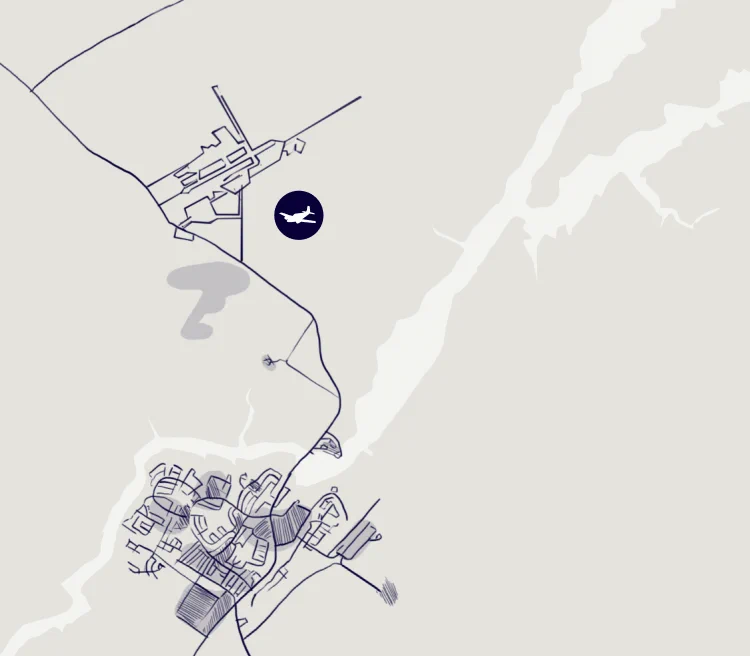
This town, located just north of Lake Winnipeg, is home to the Norway House Cree Nation. There is a small airport with a crushed rock runway and a medivac hangar that Missinippi Air pilots and medivac teams use to serve patients and drop supplies.
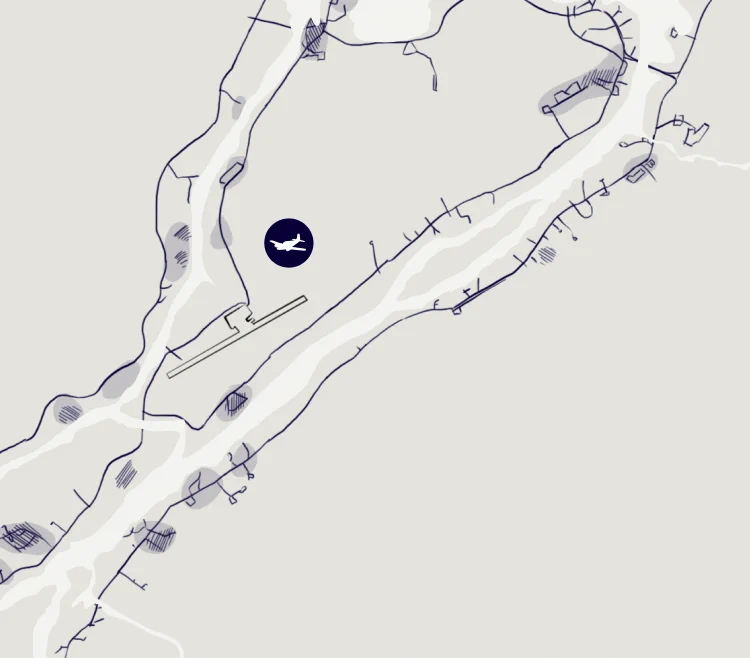
Winnipeg is a major city and a key destination for the airline’s passengers. Most medivac patients are flown here to receive care in the city’s modern hospitals and clinics. As Missinippi Airways has grown so has its presence in Winnipeg, having established an important maintenance base and new head offices at the south terminal of the city’s international airport.
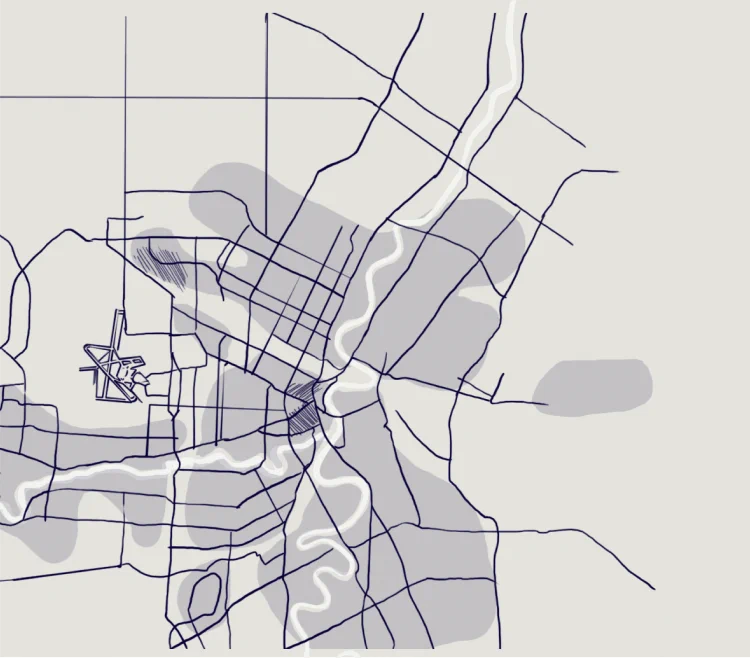

It’s a cold morning in Pukatawagan and a small group of people congregate on the platform waiting for the 8:05 train to arrive.
There is a couple expecting their daughter home from school, and a mechanic waiting on some auto parts. Others wait to get on the train; they’re travelling south for work, a hockey game, a doctor’s appointment.
No one's very happy to be there. The weather has made the winter road impassable. Right now, the train is the only way in and out of their remote northern town.
Just then the Station Master comes onto the platform. He has bad news.
“The 8:05 isn’t going to make it.”
Something about a heating system going out. Now everyone is miserable.
They complain, acknowledging shared anxieties.

By the mid-1980s Chief Pascal Bighetty, Ralph Caribou, and the other councillors of the Mathias Colomb Cree Nation in Pukatawagan, Manitoba, had had enough. Their small community, 800 KM north of Winnipeg, often had no access to basic goods and essential services. The road was only open part of the year, when the ice crossings made it safe. Rail service into town was sketchy, and didn’t run whenever it got too cold.
Their people needed more, so Chief Pascal Bighetty, Ralph Caribou, and the other councillors hatched a plan.

I’m one of the founders of Missinippi Air. Back then if we had meetings in The Pas, Winnipeg, or Flin Flon, we had to charter a flight. And Chief Pascal Bighetty always said, ‘When we buy a ticket, we hand over our money. There’s no reason why we cannot be on the other side of the desk.

Pukatawagan had a basic airstrip which was used for occasional, very expensive charter flights in and out of the community. If they owned their own planes they could fly people and products in and out on their terms.
They moved quickly and by 1987 they were in the air. It was a humble beginning. A float plane, taking off from the lake, flying under the name Beaver Air Services. Even so people loved what it did for them, and the community. Demand was heavy and soon they were making daily passenger flights from Puk to The Pas and Winnipeg.
It wasn’t long before the Council began to expand their thinking. They knew communities all over the north needed this service, and by 1989 they had secured a small fleet of hard-working turbo-prop planes and established a base at the Grace Lake Airport near The Pas, Manitoba.

What began as a way to serve their Nation and gain independence for their remote community has evolved into a successful charter airline and medivac operation serving people in over 50 First Nation communities across the north.
It’s still tough to get in and out of Pukatawagan. The winter road is weather dependent and the train still doesn’t show up some days. But now, with daily scheduled flights to The Pas, the people in this remote community have an option they can count on in an emergency.

Missinippi Airways started out with a single float plane in 1989. Today, the airline operates a growing fleet of modern aircraft, capable of transporting people and cargo all over Manitoba.


Flying air ambulance, passenger, and cargo flights through harsh weather and on gravel runways is tough on pilots, but also their planes.
That means a lot of work making sure planes are inspected and in good repair. The man in charge of this work is James Munroe. He’s the Director of Maintenance at Missinippi Airways.
He’s got a lot on his plate, keeping planes in the air while making sure all safety and air transport regulations are meticulously followed.
A big project for his team over the past few years has been upgrading the avionics in the airline’s planes to digital systems.
It hasn’t come cheap. About $350,000 per plane. That’s a lot of work and a big investment for the company but it's already paying off.

The last couple of years these planes were down for 80 plus days with avionics issues and repairs. This past year, after receiving the new upgrades, they were only down for three days.
That means planes are in the air, serving customers more safely, and generating enough extra revenue to cover the upgrades in three or four years.

At the heart of Missinippi Airways operation is a team of dedicated pilots. Flying in the north is challenging, and rough weather, remote airstrips, and little air traffic control means everyone in the cockpit needs to be highly skilled and laser focused whenever they’re on the job.

Recruiting, training, and retaining pilots is a challenge for every airline, but as a small northern operator Missinippi Airways has to work extra hard to find good pilots and keep them with the company.

The weather here in The Pas is not what people in British Columbia, or even Ontario, are used to, and that makes it challenging to get people to come up here.
A big part of their strategy is developing new pilots that can move up through the ranks. Local recruits often start in Dispatch while going to flight school. Those ready to fly start as a First Officer and work towards becoming a Captain. The company provides lots of individual certification training, which takes a lot of work, but makes the airline a great place to get your start and some real-life experience in the industry.
The airline tries to hire local and Indigenous pilots, but demand means they need to recruit from all across Canada, and increasingly from around the world.

Pilots come on, they progress, they gain hours, and a lot of times they move on to bigger companies, so we’re always changing. One of my favourite things is all the different people that come through here. Right now we have around ten immigrant workers on permits. When I do their hiring packages I always spend some time learning a little about the part of the world they’re from and what’s bringing them to freezing cold Manitoba.
One such hire is Bruno de Marchi. He’s a young pilot who’s come to northern Canada from Brazil to fly as a First Officer for Missinippi Airways.
For pilot Tim Sweeny, it was a way to come back home. He grew up in Cross Lake, Manitoba, a reserve a couple of hours drive from The Pas. After five years of flying Fire Bombers and 737s he realised the north is where he wanted to be.

Northern living is something that makes you grow. I’ve had a chance to travel all over the world but when I come home I realise this is where I am most happy. This is where I want to die. It’s my happy place.

Less than 5% of pilots in the industry are women. It’s a male dominated profession. But Missinippi Airways has always bucked that trend. Not only are some of their top pilots women, they’re Indigenous women!

Both of them had flown plenty, and each was a trailblazer who had never met another Indigenous female pilot. What they didn’t realise was that together they would become the first Indigenous female team of medivac pilots.
When Robin’s mom shared news of the two flying together on social media, they went viral!

Robin and Raven’s story inspired April O’Halloran to attend a flight training school for Indigenous pilots. She was recruited by Missinippi Airways right out of school, served as a First Officer for a few years, before being promoted to Captain in 2023.

It's tough but it’s not as tough as you think it is. If you set your goal, and you keep working at your goal, and you don’t listen to anyone who says you can’t accomplish your goal, you’ll make it just fine. It’s sad to hear that some women are put off by people who don’t think they can do it because it’s a predominantly male industry.
Medivac operations work on a gruelling 13-day rotating schedule, which is challenging for any pilot and paramedic, but even more so for Robin who is raising two small children. Fortunately, she has a strong family support network. Her father, who was a pilot himself, always encouraged her dream. And since becoming a pilot her mom has helped look after the kids when she is working.
I said to my dad, there aren’t many women pilots out there, and there’s definitely not many Indigenous pilots. He told me ‘if you can’t find a role model, then become one’.

One of Missinippi Airway’s newest female pilots is Savannah Hayes. She’s a First Officer flying with Captain Tim Sweeny, an experienced pilot who has recently come back to Missinippi Air, and Tegan McGraw, a Flight Nurse. She’s learning from her Captain, and a lot about the importance of teamwork when working on long 13-day rotations.

I’ve had the opportunity to fly with amazing female pilots and I think the industry needs more. My daughter is going through it now and I know she’ll face the ‘old boys club’ but the women who are here now are breaking barriers. Robin and Raven and April and Savannah they’re role models. So all the power to them.

While they provide a wide range of services, at the end of the day it’s Missinippi Airways’ medivac division that defines them. It’s where they get a chance to help those most in need, and provide an essential service to remote northern Indigenous communities.

That means people with major health issues must travel to the regional hospital in Thompson, which can treat some issues, but more often to Winnipeg with its large community hospitals.
Manitoba does more medivacs per capita than any province in Canada, and Missinippi Airways’ air ambulance missions represent almost 20% of the province’s total. On average they do over 1800 calls a year.
Each mission requires a high level of coordination, a little luck, and a lot of empathy.
It’s a team effort that starts with the dispatchers and a phone call from the Manitoba Transportation Coordination Centre.
Besides relaying mission instructions, Flight Dispatchers are responsible for flight tracking which ensures that the chain of command knows where all of their airplanes are at any given moment, and coordinating ground transportation at either end of a flight.
The MTCC is on the line with Cody Lane, Flight Dispatcher at Missinippi Airways. There is a young girl in Thompson who they suspect has broken her arm and needs to be taken to Winnipeg.
You have to have tough skin, to be able to handle challenging physical requirements, to deal with isolation and long shifts, and operate in small nursing stations with limited capabilities. But most of all you need to be caring and understand that the struggles people face in the north are unique.

The best part of this job is knowing you’re doing something good.

Flight paramedics have to be ready to face a lot of different scenarios on the fly. When they get the call they often don’t know the status of the patient, or even where they will be flying to. They could be helping a newborn baby or someone at the end of their life.
They also have to navigate language issues.
Advanced Flight Paramedic, Carol Stankus uses a Cree language cheat sheet but finds an open approach transcends most of the barriers.
She listens and pays close attention to the patient’s body language. She also tries her best to understand and be sensitive to cultural differences.
Of course, the job comes with a lot of perks too.
For Carol, and her colleagues, having an opportunity to work in the north, and with the Indigenous population, is the biggest reward of the job.
I had no idea what to expect from flight nursing, and found a wonderful passion. It’s definitely a chance to make a difference.